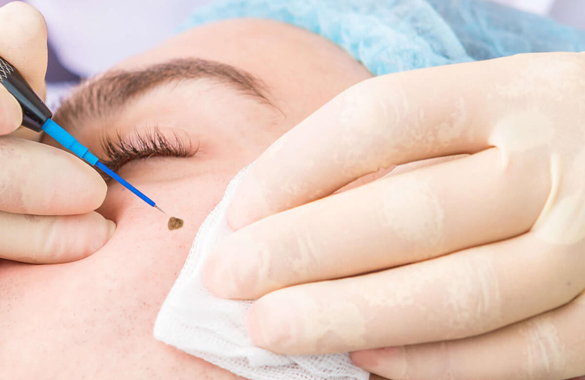


Clinically-approved mole removal procedure at DermaSure delicately eliminates superficial lesions, leaving you with a revitalised skin texture and a renewed sense of confidence
At DermaSure, you get the best mole removal treatment because we understand that moles can have a significant impact on your appearance and self-confidence. Whether you were born with them or they developed later in life, moles can come in various shapes, sizes, and colours, ranging from flesh-coloured to brown or black.
At DermaSure, our experienced dermatologists will assess your unique situation and recommend the most appropriate mole removal technique tailored to your needs. Our priority is to ensure safe, efficient, and satisfying outcomes for all our patients.
DermaSure offers a range of safe and effective mole removal techniques. Our procedures are designed to be minimally invasive and virtually painless. Here are some commonly used methods:
Moles can be classified into different types, including compound, dermal, and blue moles. Congenital nevi, present at birth, require special attention due to their increased risk of developing into skin cancer. We recommend regular examination of larger and smaller congenital nevi, promptly reporting any changes in the birthmark.
Following mole removal treatment, it’s essential to be aware of potential risks and complications. While rare, these may include mild pain, infection, temporary redness at the site, or the discharge of pus.
Allergic reactions to anaesthesia and rare instances of nerve damage can occur. In very rare cases, sepsis may develop. The size of the scar may be influenced by the initial mole size, with larger moles potentially resulting in larger scars. However, with time, scars typically fade and become less noticeable.
To mitigate risks, it is crucial to trust the expertise of skilled and qualified dermatologists. At DermaSure, our experienced specialists ensure safe and effective mole removal procedures in Delhi, prioritising your well-being.
After mole removal, it’s important to follow these care instructions for optimal healing:
Irregular or evolving moles can raise concerns about skin cancer, specifically melanoma. At DermaSure, we prioritise your well-being and offer immediate medical attention for moles that appear after the age of 30, as they may carry a higher risk of cancerous growth.
If you notice any changes in colour, shape, or the presence of scabs on a mole, it could indicate the presence of the most dangerous form of skin cancer. Don’t hesitate to consult with our experienced dermatologists if you experience pain, bleeding, itching, or a burning sensation in any mole.
DermaSure is committed to your skin health and provides comprehensive evaluations and expert care for any concerning moles. Contact us today to get rid of moles and live a life of confidence!
No, Mole removal treatment is a minimally invasive procedure that is performed under local anaesthesia. You may experience some mild soreness or discomfort after the procedure, but it can be managed with over-the-counter pain relievers.
Mole removal is generally a safe procedure. However, as with any surgical procedure, there is a small risk of infection, bleeding, scarring, or changes in skin colour. Your dermatologist will discuss the potential risks and address any concerns you may have.
The duration of the mole removal procedure depends on the size and complexity of the mole. In most cases, it can be completed within a short office visit that typically lasts between 15 to 30 minutes.
In most cases, once a mole is removed, it doesn’t grow back. However, there is a small chance of regrowth if any mole cells were left behind during the removal process. Regular follow-up appointments with your mole removal dermatologist can help ensure proper monitoring.
It is strongly recommended to avoid attempting mole removal at home using over-the-counter products. DIY mole removal can lead to complications, infections, and unsatisfactory results. It’s best to consult a dermatologist for safe and effective removal.
Mole removal is a simple procedure that does not need much attention after the surgery is complete. However, if the mole is leaving scars or bleeding then you need to see your dermatologist immediately.
Submit your review | |
Leave Them To #1 Skin & Hair Specialist In Delhi